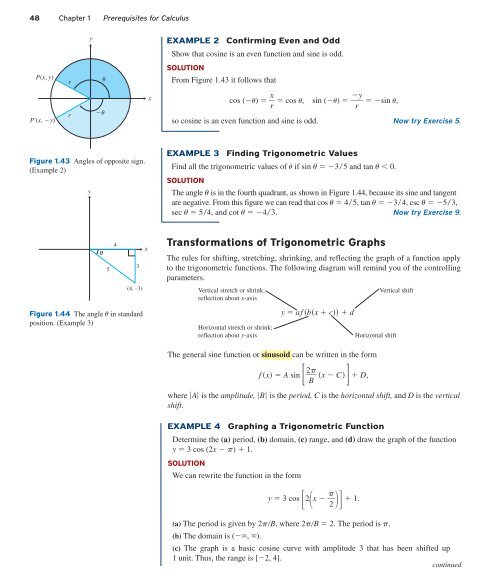Textbook Chapter 1
You also want an ePaper? Increase the reach of your titles
YUMPU automatically turns print PDFs into web optimized ePapers that Google loves.
48 <strong>Chapter</strong> 1 Prerequisites for Calculus<br />
y<br />
EXAMPLE 2<br />
Confirming Even and Odd<br />
Show that cosine is an even function and sine is odd.<br />
P(x, y)<br />
r<br />
<br />
SOLUTION<br />
From Figure 1.43 it follows that<br />
x<br />
cos (u) x cos u,<br />
r sin<br />
(u) y<br />
sin u,<br />
r<br />
P'(x, y)<br />
r<br />
<br />
so cosine is an even function and sine is odd. Now try Exercise 5.<br />
Figure 1.43 Angles of opposite sign.<br />
(Example 2)<br />
y<br />
EXAMPLE 3<br />
Finding Trigonometric Values<br />
Find all the trigonometric values of u if sin u 35 and tan u 0.<br />
SOLUTION<br />
The angle u is in the fourth quadrant, as shown in Figure 1.44, because its sine and tangent<br />
are negative. From this figure we can read that cos u 45, tan u 34, csc u 53,<br />
sec u 54, and cot u 43. Now try Exercise 9.<br />
θ<br />
(4, –3)<br />
Figure 1.44 The angle u in standard<br />
position. (Example 3)<br />
5<br />
4<br />
3<br />
x<br />
Transformations of Trigonometric Graphs<br />
The rules for shifting, stretching, shrinking, and reflecting the graph of a function apply<br />
to the trigonometric functions. The following diagram will remind you of the controlling<br />
parameters.<br />
Vertical stretch or shrink;<br />
reflection about x-axis<br />
Horizontal stretch or shrink;<br />
reflection about y-axis<br />
y afbx c d<br />
Horizontal shift<br />
Vertical shift<br />
The general sine function or sinusoid can be written in the form<br />
f x A sin<br />
[ 2 p x C<br />
B ] D,<br />
where A is the amplitude, B is the period, C is the horizontal shift, and D is the vertical<br />
shift.<br />
EXAMPLE 4<br />
Graphing a Trigonometric Function<br />
Determine the (a) period, (b) domain, (c) range, and (d) draw the graph of the function<br />
y 3 cos (2x p) 1.<br />
SOLUTION<br />
We can rewrite the function in the form<br />
y 3 cos<br />
2 x p 2 1.<br />
(a) The period is given by 2pB, where 2pB 2. The period is p.<br />
(b) The domain is (, ).<br />
(c) The graph is a basic cosine curve with amplitude 3 that has been shifted up<br />
1 unit. Thus, the range is [2, 4].<br />
continued












